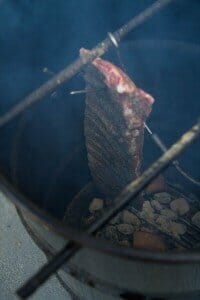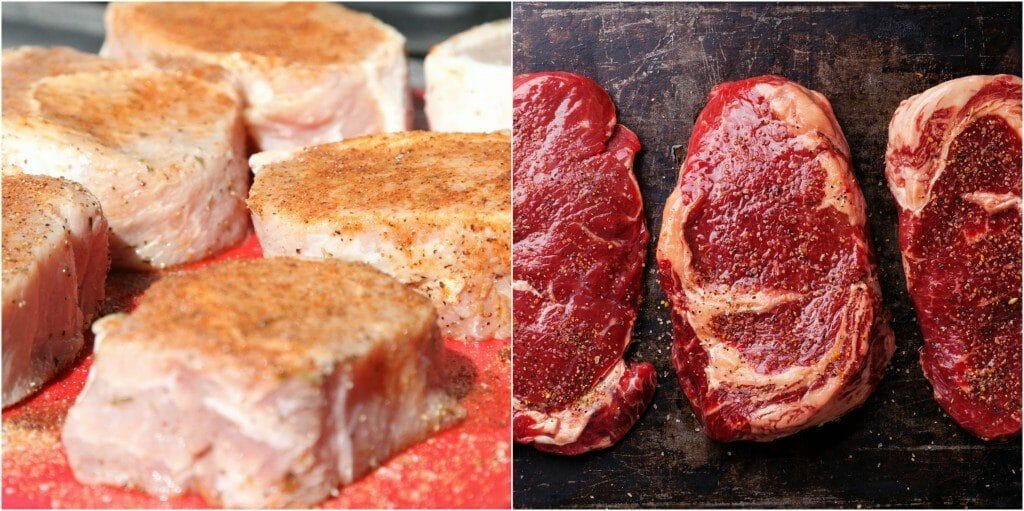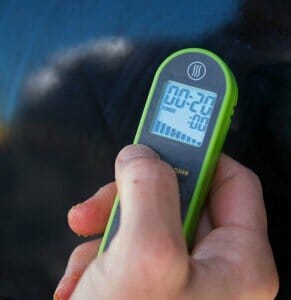
What’s the difference between grilling and BBQ? In popular culture, people use these terms interchangeably, probably because both grilling and barbecuing typically involve cooking meats outside. But there is actually a real difference between grilling and BBQ, and if you don’t know it, you’re likely to use the wrong tools and get the wrong results.
THE 4 MAJOR DIFFERENCES BETWEEN GRILLING AND BARBECUE INVOLVE:
HEAT ♦︎ TIME ♦︎ TYPE OF MEAT USED ♦︎ SMOKE
1. HEAT: THE MOST OBVIOUS DIFFERENCE BETWEEN GRILLING AND BBQ IS THE AMOUNT OF HEAT INVOLVED.
 ♦︎ Grilling is a high, direct heat method. High temperatures from either a gas grill or from glowing charcoal radiate directly below the cooking surface of the grill grate. Since the heat is only coming from one direction, the meat being cooked needs to be flipped in order to cook evenly. This direct form of heat transfer cooks the meat through radiation and conduction. Radiant heat from charcoal or gas flames and the heat energy in the grill grate transfers directly through conduction since the meat is on the grate’s surface.
♦︎ Grilling is a high, direct heat method. High temperatures from either a gas grill or from glowing charcoal radiate directly below the cooking surface of the grill grate. Since the heat is only coming from one direction, the meat being cooked needs to be flipped in order to cook evenly. This direct form of heat transfer cooks the meat through radiation and conduction. Radiant heat from charcoal or gas flames and the heat energy in the grill grate transfers directly through conduction since the meat is on the grate’s surface.
Characteristic grilled flavors come from fat that drips off the meat hitting the heat source and generating smoke that seasons the food slightly. Hot coals and gas flames (as well as flames from grease flare-ups) are in the temperature range of 2,000-3,800°F (1,093-2,093°C), and the surface of the grill grate is in the temperature range of 500-700°F (260-371°C)—depending on how many coals are being used, how high the gas is turned up, and whether or not the lid is closed (the lid is generally left open for grilling). Those are some seriously high temperatures!
 ♦︎ BBQ is a low and slow, indirect heat cooking method. The heat source cooks the meat indirectly, meaning that the coals or flame are either far below or to the side of the meat. During the cook, the lid of the grill or smoker is kept closed, and the meat is cooked through convection heat transfer as the ambient heat circulates around the meat. These moderate cooking temperatures are in the range of 200-300°F (93-149°C)—a far cry from the high temps of grilling!
♦︎ BBQ is a low and slow, indirect heat cooking method. The heat source cooks the meat indirectly, meaning that the coals or flame are either far below or to the side of the meat. During the cook, the lid of the grill or smoker is kept closed, and the meat is cooked through convection heat transfer as the ambient heat circulates around the meat. These moderate cooking temperatures are in the range of 200-300°F (93-149°C)—a far cry from the high temps of grilling!
2. TYPE OF MEAT USED: Different cuts of meat require different levels of heat to cook properly.

Meats for Grilling

Meats for BBQ
These cuts of meat are heavily worked muscles of the animal, and as such, have very tough protein and contain a web of connective tissue.
3. Time: Not only do different cuts of meat need different cooking temperatures, they need to cook for different lengths of time.
♦︎ BBQ: In barbecue, the lower temperatures and indirect heat sources take much longer to circulate around and transfer through the meat. Cook times are typically 2 hours and up—and can be as much as 18 hours,  depending on the size of the meat being cooked. Not only is time required to bring the meat up to its target temperature, but the connective tissues (like collagen) in tougher cuts take time to unwind and dissolve. Even if you were to slice a thin piece pork shoulder and cook it quickly to its target temperature on a hot grill, it would be too tough to eat because the proteins and connective tissues wouldn’t have time to break down. Collagen begins to unwind in the range of 160-170°F (71-77°C) but it takes hours to break down. Only long slow cooks over indirect heat (“low and slow”) will effectively unwind the connective tissues in these tougher cuts. When the connective tissues do unwind, they turn into silky smooth gelatin and make for very succulent eating.
depending on the size of the meat being cooked. Not only is time required to bring the meat up to its target temperature, but the connective tissues (like collagen) in tougher cuts take time to unwind and dissolve. Even if you were to slice a thin piece pork shoulder and cook it quickly to its target temperature on a hot grill, it would be too tough to eat because the proteins and connective tissues wouldn’t have time to break down. Collagen begins to unwind in the range of 160-170°F (71-77°C) but it takes hours to break down. Only long slow cooks over indirect heat (“low and slow”) will effectively unwind the connective tissues in these tougher cuts. When the connective tissues do unwind, they turn into silky smooth gelatin and make for very succulent eating.
4. SMOKE: SMOKEY FLAVORS TAKE TIME TO DEVELOP.
♦︎ Grilling: Smoke is not used in grilling. The high temperatures on a grill produce flare-ups, not significant smoke. However, smoke can be used in the hybrid cooking method called grill-roasting.
Smoke is the essence of barbecue. it is what differentiates barbecue from other types of cooking. —Meathead, AmazingRibs.com

